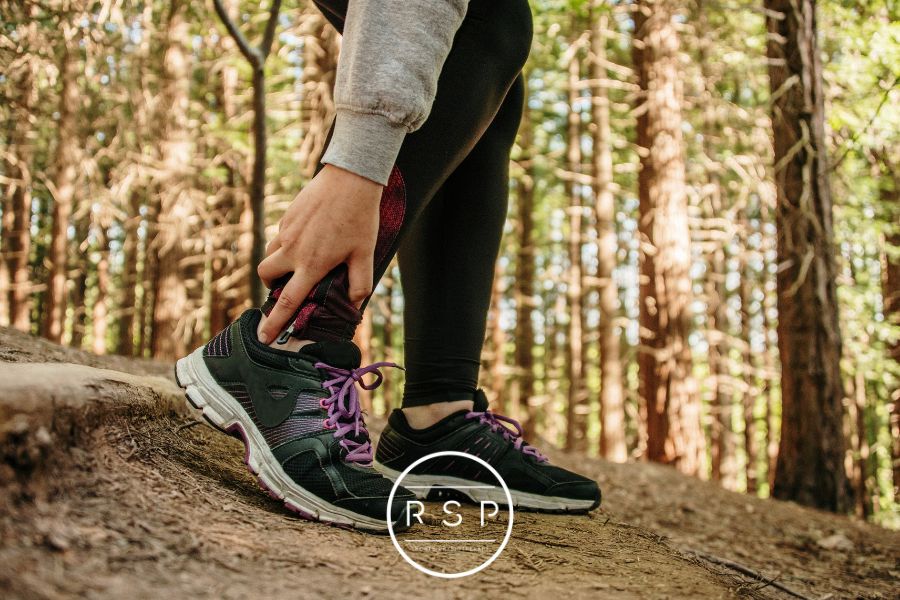Ankle sprains are a prevalent ailment in the active population, whether it’s netball, rugby or playing with your kids at the local playground. Lateral ankle sprains (LAS) are particularly common in young active people and have a high incidence and high recurrence rates.
A clinical study observed that at three months post-ankle sprain, 65% of participants reported ongoing instability, and 24% reported one or more re-sprains. At the 12-month follow-up, 55% still reported instability, and more than half considered themselves not fully recovered. As a result, we must consider the notion that there is no such thing as a simple ankle sprain. Even the most basic ankle sprain can be complex, requiring meticulous care and treatment.
The three types of ankle sprains
Ankle sprains are classified into several types. The mechanism of injury determines the type of ankle sprain sustained. The ankle complex has a unique osseous morphology, consisting of 2 major joints: the talocrural and distal tibiofibular joint. The 4 major areas of instability occur at the anterior, medial & lateral ankle, as well as the distal tibiofibular (syndesmosis) joint. As a result, ankle sprains are classified into the following three types:
1. Lateral Ankle Sprain
Lateral ankle sprains occur when the ankle rolls outward, causing the sole of the foot to roll in. This causes damage to the ankle’s ligaments, including the anterior talofibular (ATFL), calcaneofibular (CFL), and posterior talofibular (PTFL) ligaments. The ATFL is the most common ligament sprained and resists anterior translation of the talus and is related to anterior instability.
2. Medial Ankle Sprain
Medial ankle sprains occur when the ankle rolls inward (causing the sole of the foot to roll out). The medial ankle is anatomically complex and robust, with five ligaments (the deltoid ligament) spanning across the talocrural, subtalar and talonavicular joints. The deep portions only cross the talocrural joint, which is comprised of the anterior tibiotalar (ATTL) and the posterior tibiotalar ligament (PTTL). The superficial portions, which include the tibionavicular (TNL), tibiospring (TSL) and the tibiocalcaneal ligament (TCL), additionally cross the subtalar & talonavicular joint. The deep and superficial layers resist external rotation and eversion of the talus, respectively.
This type of sprain is less common because the deltoid ligament is so thick and robust. This type of injury can often be coupled with a more serious fracture or syndesmosis injury.
3. High ankle sprains
The syndesmosis is incredibly important to maintain functional stability of the talocrural joint. Distal tibiofibular instability is caused by an injury to the anteroinferior tibiofibular ligament (AITFL), posteroinferior tibiofibular ligament (PITFL) and the interosseous membrane, most commonly known as syndesmosis injuries. These injuries can often require time in a moonboot and sometimes surgery. Immediate assessment is required if you sustain a high ankle sprain.

Recovering from an ankle sprain
After the acute phase, it is essential to revive principal characteristics often seen as crucial for lateral ankle sprains, such as decreased range of motion in the ankles, inadequate proprioception and balance control, and weakened peroneal muscles alongside calf muscles. The rehabilitation of the intrinsic foot muscles is also important post-ankle sprain, even more so if a moonboot was prescribed.
Physiotherapy treatment for an ankle sprain
Ankle rehabilitation may consist of the following:
- Strength training
- Plyometric (e.g. hopping) exercises
- Mobility and flexibility training
- Proprioception and balance training
Range of Motion
Restoration of weight-bearing dorsiflexion is particularly important as it’s been shown to negatively influence hip and knee biomechanics, as well as increase risk of recurrent ankle sprains and other lower limb injuries. An asymmetry of 1-1.5cm is normal, but anything beyond this could be associated with an ankle sprain.
Strength
In the early stages of rehabilitation, various resistance-band programs have been shown to improve peak torque of the invertors, evertors and dorsiflexors (Hall, Docherty, Simon, Kingma, & Klossner, 2015; Ismail, Ibrahim, Youssef, & Shorbagy, 2010). Collado et al (2009) demonstrated that eccentric resistance restored muscle strength more effectively than concentric training. The addition of plyometric drills (e.g. jumping, hopping) to traditional resistance-band programs over a 6-week period significantly improved functional performance, which was highlighted by large improvements in calf strength and endurance, as well as single leg balance (Ismail et al., 2010). Calf strength should also be biased towards the soleus via seated or flexed knee calf raises due to the large role it plays in ground reaction forces, performing above 6x our body weight (Dorn, Schache, & Pandy, 2012).
Neuromuscular & Proprioceptive Control
Balance training can be utilised very early in rehabilitation as it is quite gentle and well tolerated by patients. The use of a bosu and unstable surfaces to challenge simple balance tasks can facilitate great improvement in the Y-balance test and hop testing, both effective measures of dynamic ankle control (Wang, Yu, Kim, & Kan, 2021). This form of training also improves the peak torque of ankle muscles in additional to traditional resistance, but it can also have a greater improvement to the reaction time.
Sport-Specific Training & Plyometrics
The demands of an ankle will vary greatly depending on the chosen sport or recreational activity of the patient. As a result, sport-specific training should replicate the chosen sport as closely as possible before commencing a controlled & restricted return to training. The ‘control-chaos continuum’ is a fantastic way to theorise the return to sport-specific training for any athlete, moving from slower and more controlled drills to faster and more chaotic drills as they near return to sport (Taberner, Allen, & Cohen, 2019). These drills will largely replicate plyometric drills, which in addition to facilitating ankle-specific rehabilitation, they’ve been shown to improve a range of athletic performance measures including sprint & acceleration performance, vertical jump performance and improve muscle strength, when used in isolation or in conjunction with traditional weight programs (Ismail et al., 2010). Given the weight of support of plyometric exercise, they should be included as early as clinically appropriate and given high priority. Concurrently to their rehabilitation program, it’s advisable for the athlete to also be conducting appropriate cross training and weights training for the remainder of their body. This is important to maintain cardiovascular fitness and adjacent joint & muscle strength throughout the rehabilitation process (Doherty, Bleakley, Delahunt, & Holden, 2017).
What are the long-term effects of a sprained ankle?
If neglected, a sprained ankle may bring about severe consequences – such as ongoing pain and instability in the joint. To avoid these possible repercussions of improper care or returning to your activities before full recovery, you must take the time for proper rehabilitation following an injury and seek physiotherapist input as soon as possible.
How do I know when my sprained ankle is fully healed?
We have an in-depth return to sport process in our clinic utilising both clinical experience and knowledge, as well as state of the technology (e.g. dynamometers, force plates). Your physiotherapist will assist you throughout the rehabilitation process to ensure you’re on the right path.

Final thoughts on ankle sprains
Though a sprained ankle may not seem serious, it’s important to consider how complex the injuries can be. Treating your sprain as quickly and effectively as possible is critical to avoiding more severe issues down the road, so don’t hesitate to seek a professional physiotherapist to ensure the best outcome for yourself.
With proper care and attention, you can recover from an ankle sprain in no time and keep on living your life with full mobility.
Book an appointment if you have any questions regarding ankle injuries. We will provide you with a full assessment and treatment plan tailored to your needs.



